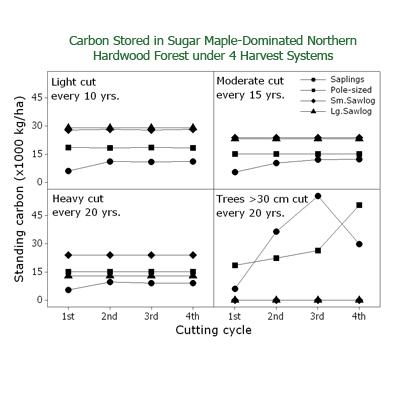Management Effects on Sustainable Wood Production and Carbon Sequestration in Uneven-aged Northern Hardwood Forests

The role of forests in the global carbon cycle has become the focus of much research in the last decade as a result of global climate change and creation of carbon markets. With the important role that forests play in the carbon cycle, it is essential that forest managers explore potential opportunities for increasing terrestrial carbon sequestration, or storage, through sustainable silviculture (growth, harvest, and regeneration of trees).
To evaluate and compare how three different selective harvest systems influence carbon budgets in the Northern Forest, NSRC researchers used a growth and yield computer simulator to predict sequestered carbon and harvested wood volume for uneven-aged sugar maple-dominated northern hardwood stands over three cutting cycles. Four management options were considered: three selection system harvests with residual tree densities of 21.1 m2 per hectare, with a 10-year cutting cycle; 17.2 m2 per hectare, with a 15-year cutting cycle; and 14.9 m2 per hectare, with a 20-year cutting cycle; and a diameter-limit cutting of trees 30 cm and greater, with a 20-year cutting cycle.
Findings revealed that the first three options provided consistent, commercially acceptable levels of timber production while maintaining a reserve carbon stock through three cutting cycles. Management resulted in vigorous growth which increased carbon sequestration over the three successive cutting cycles. The fourth option failed to produce an operable cut after the first entry and resulted in the lowest levels of sequestered carbon. This suggests that selection system designs have the flexibility to mesh landowners’ carbon and timber objectives successfully in uneven-aged sugar maple-dominated northern hardwood forests.
Download printable version [PDF]
Download full final report [PDF]
